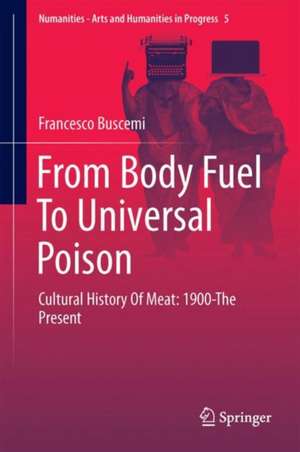From Body Fuel to Universal Poison: Cultural History of Meat: 1900-The Present: Numanities - Arts and Humanities in Progress, cartea 5
Autor Francesco Buscemien Limba Engleză Hardback – 4 ian 2018
This book explores our changing relationship with meat as food. Half storytelling and half historic work, it analyzes the way in which humans have dealt with the idea of eating animals in the Western world, from 1900 to the present.
The story part of the book follows the rise and fall of meat, and illustrates how this type of food has become a problem in a more emotional way. The historical component informs and offers readers key data. The author draws on theories of circular societies, smart cities and smart countries to explain how and why forms of meat production that were common in the past have since all but disappeared.
Both components, however, explain why meat has been important and why it has now become a problem. In tracing the fall of meat, the author identifies a host of dilemmas. These include fossil energy, pollution, illnesses caused by eating meat, factory farming, and processed foods.
Lastly, the book offers a possible solution. The answer focuses on new forms of meat obtained without killing animals and in a sense resembles renewable energy. Overall, this unique cultural history offers revealing insights into how meat affects social relations, interpersonal relationships, and humanity as a whole.
| Toate formatele și edițiile | Preț | Express |
|---|---|---|
| Paperback (1) | 495.83 lei 38-45 zile | |
| Springer International Publishing – 6 iun 2019 | 495.83 lei 38-45 zile | |
| Hardback (1) | 640.55 lei 3-5 săpt. | |
| Springer International Publishing – 4 ian 2018 | 640.55 lei 3-5 săpt. |
Din seria Numanities - Arts and Humanities in Progress
- 18%
 Preț: 729.53 lei
Preț: 729.53 lei - 18%
 Preț: 941.82 lei
Preț: 941.82 lei - 24%
 Preț: 580.92 lei
Preț: 580.92 lei - 15%
 Preț: 651.84 lei
Preț: 651.84 lei -
 Preț: 414.66 lei
Preț: 414.66 lei -
 Preț: 393.90 lei
Preț: 393.90 lei -
 Preț: 378.12 lei
Preț: 378.12 lei - 15%
 Preț: 636.80 lei
Preț: 636.80 lei - 20%
 Preț: 559.86 lei
Preț: 559.86 lei -
 Preț: 381.81 lei
Preț: 381.81 lei -
 Preț: 388.72 lei
Preț: 388.72 lei - 18%
 Preț: 733.15 lei
Preț: 733.15 lei - 15%
 Preț: 639.90 lei
Preț: 639.90 lei - 18%
 Preț: 725.13 lei
Preț: 725.13 lei - 18%
 Preț: 785.24 lei
Preț: 785.24 lei - 18%
 Preț: 724.94 lei
Preț: 724.94 lei - 15%
 Preț: 696.68 lei
Preț: 696.68 lei - 15%
 Preț: 638.57 lei
Preț: 638.57 lei - 15%
 Preț: 647.27 lei
Preț: 647.27 lei - 24%
 Preț: 679.08 lei
Preț: 679.08 lei -
 Preț: 420.20 lei
Preț: 420.20 lei - 18%
 Preț: 727.48 lei
Preț: 727.48 lei - 15%
 Preț: 527.32 lei
Preț: 527.32 lei -
 Preț: 385.29 lei
Preț: 385.29 lei -
 Preț: 391.40 lei
Preț: 391.40 lei -
 Preț: 380.25 lei
Preț: 380.25 lei
Preț: 640.55 lei
Preț vechi: 753.60 lei
-15% Nou
Puncte Express: 961
Preț estimativ în valută:
122.57€ • 127.97$ • 101.44£
122.57€ • 127.97$ • 101.44£
Carte disponibilă
Livrare economică 14-28 martie
Preluare comenzi: 021 569.72.76
Specificații
ISBN-13: 9783319720852
ISBN-10: 3319720856
Pagini: 154
Ilustrații: IX, 154 p. 8 illus. in color.
Dimensiuni: 155 x 235 mm
Greutate: 0.42 kg
Ediția:1st ed. 2018
Editura: Springer International Publishing
Colecția Springer
Seria Numanities - Arts and Humanities in Progress
Locul publicării:Cham, Switzerland
ISBN-10: 3319720856
Pagini: 154
Ilustrații: IX, 154 p. 8 illus. in color.
Dimensiuni: 155 x 235 mm
Greutate: 0.42 kg
Ediția:1st ed. 2018
Editura: Springer International Publishing
Colecția Springer
Seria Numanities - Arts and Humanities in Progress
Locul publicării:Cham, Switzerland
Cuprins
Introduction.- Chapter 1 The Complex Identity of Meat.- Chapter 2 - 1900-1918: The Normality of Meat.- Chapter 3 - 1919-1945: Meat Propaganda.- Chapter 4 - 1946-1960: A New Fuel for the Body.- Chapter 5 – 1961-1980: The Detachment between Meat and the Animal.- Chapter 6 - 1980-Today: The Illness of Meat.- Chapter 7 – Today- The Future: Meat Forecast.- Conclusion.
Textul de pe ultima copertă
This book explores our changing relationship with meat as food. Half storytelling and half historic work, it analyzes the way in which humans have dealt with the idea of eating animals in the Western world, from 1900 to the present.
The story part of the book follows the rise and fall of meat, and illustrates how this type of food has become a problem in a more emotional way. The historical component informs and offers readers key data. The author draws on theories of circular societies, smart cities and smart countries to explain how and why forms of meat production that were common in the past have since all but disappeared.
Both components, however, explain why meat has been important and why it has now become a problem. In tracing the fall of meat, the author identifies a host of dilemmas. These include fossil energy, pollution, illnesses caused by eating meat, factory farming, and processed foods.
Lastly, the book offers a possible solution. The answer focuses on new forms of meat obtained without killing animals and in a sense resembles renewable energy. Overall, this unique cultural history offers revealing insights into how meat affects social relations, interpersonal relationships, and humanity as a whole.
Caracteristici
Explores our changing relationship with meat as food Combines narrative with history to offer an engaging cultural history Identifies key problems and discusses possible solutions Includes supplementary material: sn.pub/extras
